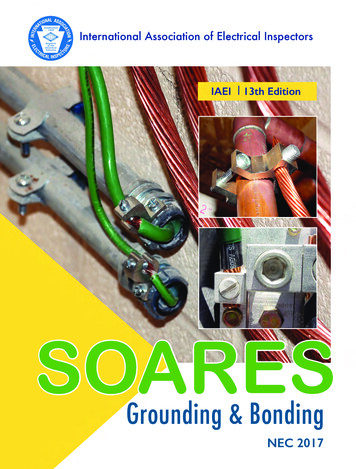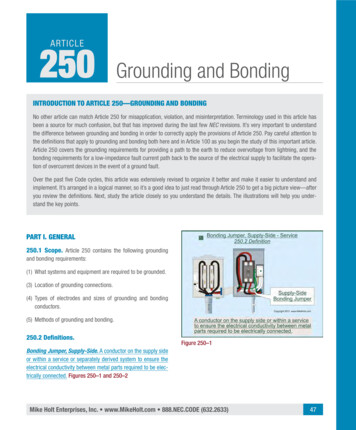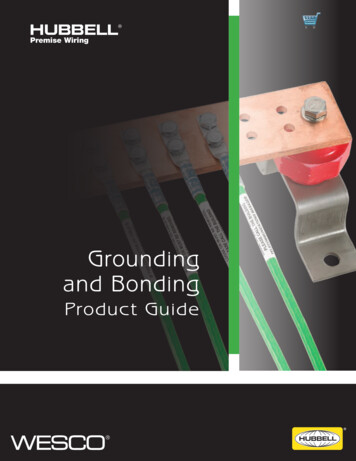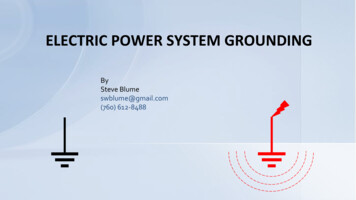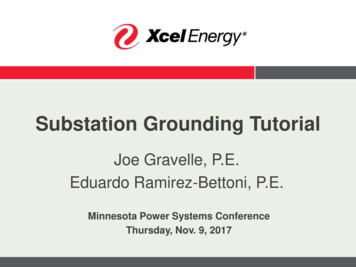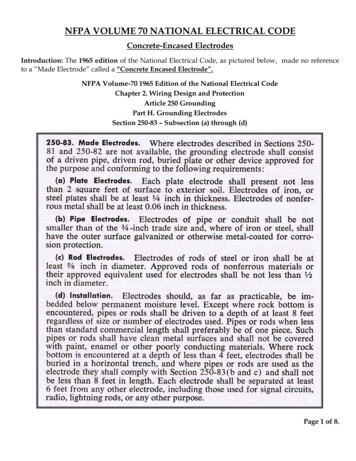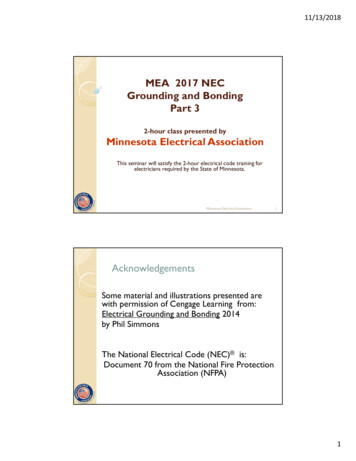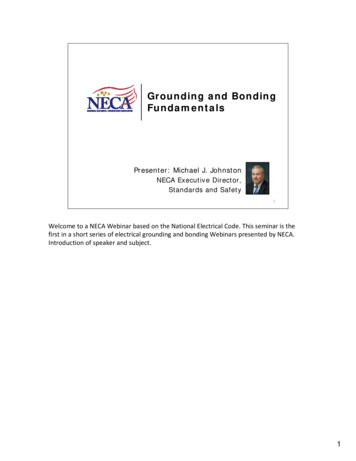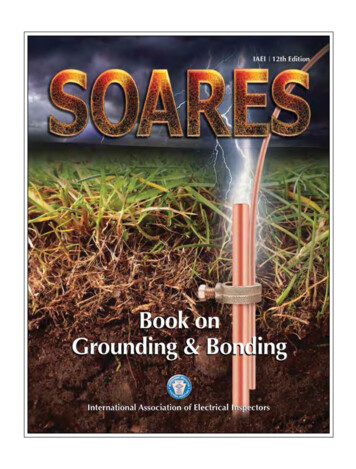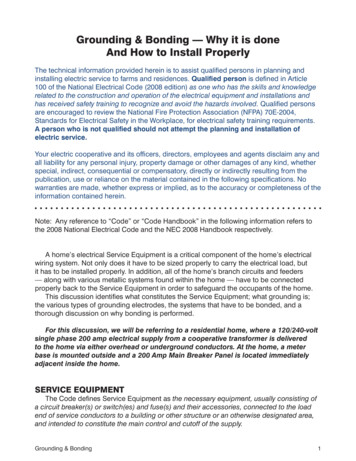
Transcription
Grounding & Bonding — Why it is doneAnd How to Install ProperlyThe technical information provided herein is to assist qualified persons in planning andinstalling electric service to farms and residences. Qualified person is defined in Article100 of the National Electrical Code (2008 edition) as one who has the skills and knowledgerelated to the construction and operation of the electrical equipment and installations andhas received safety training to recognize and avoid the hazards involved. Qualified personsare encouraged to review the National Fire Protection Association (NFPA) 70E-2004,Standards for Electrical Safety in the Workplace, for electrical safety training requirements.A person who is not qualified should not attempt the planning and installation ofelectric service.Your electric cooperative and its officers, directors, employees and agents disclaim any andall liability for any personal injury, property damage or other damages of any kind, whetherspecial, indirect, consequential or compensatory, directly or indirectly resulting from thepublication, use or reliance on the material contained in the following specifications. Nowarranties are made, whether express or implied, as to the accuracy or completeness of theinformation contained herein.Note: Any reference to “Code” or “Code Handbook” in the following information refers tothe 2008 National Electrical Code and the NEC 2008 Handbook respectively.A home’s electrical Service Equipment is a critical component of the home’s electricalwiring system. Not only does it have to be sized properly to carry the electrical load, butit has to be installed properly. In addition, all of the home’s branch circuits and feeders— along with various metallic systems found within the home — have to be connectedproperly back to the Service Equipment in order to safeguard the occupants of the home.This discussion identifies what constitutes the Service Equipment; what grounding is;the various types of grounding electrodes, the systems that have to be bonded, and athorough discussion on why bonding is performed.For this discussion, we will be referring to a residential home, where a 120/240-voltsingle phase 200 amp electrical supply from a cooperative transformer is deliveredto the home via either overhead or underground conductors. At the home, a meterbase is mounted outside and a 200 Amp Main Breaker Panel is located immediatelyadjacent inside the home.SERVICE EQUIPMENTThe Code defines Service Equipment as the necessary equipment, usually consisting ofa circuit breaker(s) or switch(es) and fuse(s) and their accessories, connected to the loadend of service conductors to a building or other structure or an otherwise designated area,and intended to constitute the main control and cutoff of the supply.Grounding & Bonding1
In our example, the Service Equipment for the home is the 200 Amp Main BreakerPanel. However, if this 200 Amp Main Breaker Panel can’t be immediately installed on theother side of the wall from the meter base, the electric cooperative may require a 200 AmpMain Disconnect be installed immediately after the meter base. (Note: The authority havingjurisdiction — in many cases that is the electric cooperative — will determine what the lengthof run can be between meter base and the Main Breaker Panel before a Main Disconnect isneeded. The Code does not specify this length.) See exhibits 1 & 2.If a Main Disconnect is installed, the electrician would also need to install inside thehome a 200 Amp Lug Main Panel (“Lug Main” means without a Main Breaker). In this typeof arrangement — the Service Equipment would consist of just the Main Disconnect — andnot include the lug main breaker panel inside the home.It is interesting to note that even though the meter base is usually installed when theService Equipment is installed — the Code does not recognize it as part of the ServiceEquipment according to 230.66.Also, when installing conduit between the meter base and the Service Equipment, nonmetallic conduit is preferred over metal. The reason is simple. The neutral terminal in themeter base is by design connected to the metal enclosure of the meter base — and theneutral conductor is bonded to the metal enclosure of the Service Equipment. So, whenone use metallic conduit between the meter base and the Service Equipment, any neutralcurrent between the meter base and the Service Equipment is being shared by both theneutral conductor and the metallic conduit — because in essence — they are in parallel.Grounding & Bonding2
Service EquipmentMainBreakerPanelExhibit 1MainBondingJumperMeter BaseNon-metallicConduitGrounding & BondingMounted Immediatelyafter meter base oninterior wall.3
Exhibit 2Main DisconnectMeter BaseMounted Immediatelyafter meter base oninterior wall.Service EquipmentNon-metallicConduitMainBondingJumperLug Main Breaker PanelNon-metallicConduit4Grounding & Bonding
GROUNDING AND BONDING“Grounding” and “bonding” are important elements of a building’s electrical wiringsystem. They each have different functions, but they work together to make the building’selectrical wiring safe.The Code defines “grounding” as the connecting to ground or to a conductive body thatextends the ground connection — and the Code defines “ground” as the earth. Basically,grounding is connecting to the earth. The Code defines “bonded” or “bonding” asconnected (connecting) to establish electrical continuity and conductivity.Let’s examine these two important integral parts of electric wiring closer in detail.GroundingIn our home example, a typical electrical installation will require the electrician toconnect the house’s wiring to the earth. This practice is called “grounding” and it is doneto limit the voltage imposed by lightning, line surges, or unintentional contact withhigher-voltage lines and to stabilize the voltage to earth during normal operation asdocumented by 250.4(A)(1) of the Code.Grounding is necessary to prevent fires starting from a surface arc within the home. Ifthe outdoor wiring supplying the home should be struck by lightning, proper grounding bythe electrician directs that voltage into the earth where it dissipates.Because 250.26 of the Code requires the neutral conductor of a single-phase, 3-wiresystem to be grounded, in our example, the electrician will normally use a bare copper wireto connect the neutral conductor (often called the grounded conductor) to a groundingelectrode that has direct contact with the earth.Location of the Grounding ConnectionEach premises wiring system supplied by a grounded ac service shall have a groundingelectrode conductor connected to the grounded service conductor — at each service —according to 250.24(A) of the Code. Basically, this is saying each building that is servedelectricity shall have its service connected to the earth.250.24(A)(1) of the Code allows this grounding connection (earth connection) to be atvarious locations. It says the grounding electrode conductor connection shall be made atany accessible point from the load end of the service drop or service lateral to and includingthe terminal or bus to which the grounded service conductor is connected at the servicedisconnecting means. See exhibit 3.Please note that the Code does not indicate that a meter base enclosure is not anaccessible location for terminating a grounding electrode conductor. These enclosures aresometimes viewed this way because of the seal that the cooperative puts on them to placea legal jurisdiction over the unmetered conductors contained in the enclosure.However, any way you look at this connection location, it is still accessible (by definition)to workers and others, by legal means. In other words, just notify the cooperative andaccess can be granted beyond the seal. Besides, this earthing connection is made inthe meter base before it is energized and before the seal or lock is installed. Some localjurisdictions may not permit the connection to be made in the meter base enclosure, butthat is not the intent of the Code — the Code does allow it.Here is a suggestion. If one would always make the earth connection in the ServiceEquipment, it would always be according to Code. And it would always be easily accessibleto an insurance agent/electrical inspectors inspecting the electrical wiring, and to electricianstroubleshooting future grounding issues if they arise. However, it is stressed that the bestprocedure is to verify with the electric cooperative where they want the earth connection.Grounding & Bonding5
At load endof service dropExhibit 3Connection to earth canbe at three locations.In accessiblemeter enclosureService EquipmentIn servicedisconnectingmeansGrounding & Bonding6
Grounding ElectrodesBecause grounding electrodes are absolutely essential to direct dangerous highvoltages to the earth, 250.50 of the Code requires several different items of a building toserve as grounding electrodes. Building a system of electrodes adds a level of reliability —and helps ensure system performance over a long period of time — instead of relying on asingle grounding electrode to perform its function over the life of an electrical installation.All of the following 7 electrodes that are present at a building shall be bonded togetherto form the entire grounding system:1. Metal underground water pipe (including any well casing bonded to the pipe) Pipe has to be in direct contact with the earth for 10 feet or more Metal can be steel, iron, cast iron, stainless steel Code doesn’t define whether the water piping is for potable water, fire protectionsprinkler system, irrigation, etc. — so all of these different water systems have tobe used as grounding electrodes Interior metal water piping located more than 5 feet from the point of entrance tothe building shall not be used as part of the grounding electrode system — oras an conductor to interconnect other electrodes that are part of the groundingelectrode system. Continuity of the grounding path shall not rely on water meters or filtering devicesor similar equipment according to 250.53(D)(1) of the Code. Bonding jumpers shallbe connected around meters, filtering devices and similar equipment. If metal underground water pipe is used as the sole grounding electrode system,according to 250.53(D)(2) of the Code, it has to be supplemented with othergrounding electrodes as listed in this section. The reason for this is based on thepossibility of using a plastic water pipe in the future when the original metal waterpiping fails — leaving the electrical system without any grounding electrode. Thesupplemental electrode can be connected to any of the following:Grounding electrode conductorGrounded service conductorMetal service racewayMetal service enclosure2. Metal frame of the building Frame has to be in direct contact with the earth for 10 feet or more Frame must be connected to an acceptable electrode; or other approved means ofestablishing connection to earth3. Concrete-encased electrodeNote: This electrode is commonly referred to as the “Ufer ground”; and concreteencased is referring to the electrode being part of the building’s footing or foundation.According to the Code Handbook If a concrete-encased electrode is not present ata building, it is not required that one be installed. An exception does exempt buildingswhere access to a concrete encased electrode would involve some type of demolitionor similar activity that would disturb the existing construction. Because the installationof the footings and foundation is one of the first elements of a construction projectand in most cases has long been completed by the time electric service in installed,this rule necessitates an awareness and coordinated effort on the part of designersand the construction trades in making sure that the concrete encased electrode isincorporated into the grounding electrode system.Grounding & Bonding7
4.5.6.7.This electrode must be: Encased by at least 2” of concrete Located horizontally near the bottom of the concrete encasement or installedvertically A #4 AWG or larger bare copper conductor at least 20 feet in length OR areinforcing rod not less than ½” in diameter made of bare, zinc galvanized or otherelectrically conductive coated steel material at least 20 feet in length. This 20 ftmeasurement can be accomplished by bonding reinforcing rods together with theusual steel tie wires or other means like welding.Ground Ring Must encircle the building Must have 20 feet in contact with the earth Must be bare copper not smaller than #2 AWG Must be buried not less than 30 inches — according to 250.53(F) of the CodeRod and Pipe Electrodes Must not be less than 8 feet in length 8 feet of this electrode must be in contact with earth Diameter and materialnot smaller than ¾ inch if of pipe or conduit material and outer surface must begalvanized or otherwise metal-coated for corrosion protectionnot smaller than 5/8 inch if of stainless steel and copper or zinc coated steelnot smaller than ½ inch if of stainless steel and copper or zinc coated steel and islistedOther listed electrodesPlate electrodes 2 square feet of surface must be exposed to earth Must be installed at least 30 inches deepGrounding & Bonding8
Metal frame ofbuildingExhibit ionsmade within 5 ftof point ofentrance of pipeConcrete-encasedelectrode (ufer)Ground rodGrounding & BondingMetal undergroundwater pipeGround ring9
If none of these 7 types of grounding electrodes exist, then one or more of the followinggrounding electrodes must be installed and used (see descriptions above): Bare Copper Ground Ring Rod and pipe electrodes Other listed electrodes Plate electrodes Other local metal underground systems or structures (e.g., underground metalstorage tank, metal well casings not bonded to metal water pipe) It is important to note that metal underground gas piping systems are notpermitted for use as grounding electrodes according to 250.52(B) of the Code.The connection of grounding electrodes to the grounded conductor can be performed inthree ways as shown in exhibit 5.1) Grounding electrode conductors can run individually from the grounded conductordirectly to a grounding electrode.2) A grounding electrode conductor can run from the grounded conductor to agrounding electrode. Then from that point on, bonding jumpers can be used toconnect other grounding electrodes in a daisy chain fashion.3) A combination of (1) and (2).Grounding & Bonding10
ServiceequipmentMAINONOFFIndividual groundingelectrode condictorsExhibit 5ServiceequipmentMAINBonding jumpersbetween groundingelectrodesONOFFGrounding electrode conductorGrounding & Bonding11
From Grounding to BondingGrounding and bonding work together with each other to make a building’s electricalwiring safe. Once the electrician has completed the connection of the grounded conductorto the earth, the focus now moves from the concept of grounding to bonding. This transitionis started through use of a device called the Main Bonding Jumper.250.24(B) of the Code requires the electrician to connect the grounded serviceconductor to the metal enclosure of the Service Equipment and to the equipment groundingterminal bar within the Service Equipment. This connection can be accomplished throughvarious types of Main Bonding Jumpers — including a wire, bus, screw, or similar suitableconductor.If the Main Bonding Jumper is a screw, the screw head shall be green-colored accordingto 250.28(B) of the Code. (Note: If the Main Bonding Jumper is a wire or busbar, 250.24(A)(4) allows the grounding electrode conductor to connect to the equipment groundingterminal bar — instead of to the neutral terminal bar.)Once grounding has been performed and the Main Bonding Jumper has beenconnected — the grounded conductor (neutral) — which is attached to the neutral terminalbar in the Service Equipment — is also now connected to the: earth metal enclosure of the Service Equipment grounding electrode conductor equipment grounding terminal bar of the Service EquipmentThis next statement is critical. In order for the electrical wiring in the home tobe safe, this is the only location in the entire wiring of the home — andin other buildings and structures supplied by this Service Equipment —where the grounded conductor (neutral) can be connected to the other 4components listed above. From this point on — when working with branch circuitsor feeders supplied from the Service Equipment — all neutral conductors have to be keptseparate from: all equipment grounding conductors and the metallic parts of branch circuits metallic enclosures, equipment grounding conductors, and grounding electrodeconductors of downstream disconnecting meansExhibits 6 & 8 show approved wiring methods and exhibits 7 & 9 show violations.Grounding & Bonding12
Exhibit 6Correctly WiredMeter BaseService EquipmentNon-metallicConduitCoonected toCooperative NRemote Building ductorG13Grounding & Bonding
Exhibit 7Incorrectly WiredMeter BaseService EquipmentCoonected toCooperative Remote Building Grounding & Bonding
Exhibit 8Correctly WiredMeter BaseService EquipmentNon-metallicConduitCoonected toCooperative NSub Panel Located in Same ctorG15Grounding & Bonding
Exhibit 9Incorrectly WiredMeter BaseService EquipmentNon-metallicConduitCoonected toCooperative NViolationSub Panel Located in Same ctorG16Grounding & Bonding
Bonding:Once the electrician has completed grounding of the Service Equipment and theattachment of the Main Bonding Jumper within the Service Equipment, it’s time to performanother critical step in the house’s electrical wiring. As the electrician installs the branchcircuits in the house, focus is now concentrated on making sure that the metal componentsin all of the branch circuits are connected to the metal enclosure of the Service Equipment— an act called “bonding”.Bonding is accomplished when the electrician connects equipment groundingconductors to the equipment grounding terminal bar in the Service Equipment and to thegrounding terminals on electrical devices and electrical boxes. If the electrician is usingmetal raceways and metal boxes to install conductors — the electrician can also use themetal raceway conduit as the equipment grounding conductor, but great care needs to betaken when using this method. Connections at each conduit joint and box must use properequipment and methods to ensure a solid connection has been made.When installed correctly, here is a way to visualize what proper bonding does. Imaginetaking one lead of a continuity tester and touch a metal component of one circuit (box,enclosure, conduit, locknut, appliance frame, etc.,) — and then take the other (extremelylong!) lead anywhere in the building and touch a similar metal component used either inthe same circuit or in a different electrical circuit. If bonding was properly performed, thecontinuity tester would show continuity between the two places being touched. Basically, allmetal components have become “one unit.”That’s why — even when one is using plastic switch boxes and plastic switch covers forinstalling switches — the electrician is required to use switches with a grounding terminaland conductors that include an equipment grounding conductor. Because of the possibilityof a metal switch cover being used some day, the electrician once again has to ensurethat the metal cover has a conductive path back to all metallic parts of its circuit and othercircuits and the metal enclosure of the Service Equipment.You may be wondering if one is using equipment “grounding” conductors andconnecting to “grounding” terminals, then why isn’t this considered an act of grounding?It’s a great question. The best way to answer it is to say it’s really both bonding andgrounding. Grounding and bonding happen simultaneously during the installation of anelectrical system and branch circuits. They work hand in hand in order to make it safe.The Code describes bonding as connecting to establish electrical continuity andconductivity — and describes grounding as connecting directly to ground (earth) or to aconductive body that extends the ground connection. Let’s see how they work together.Consider the example where one connects an equipment grounding conductor in a nonmetallic Romex cable to the grounding terminal of a 120-volt duplex receptacle. One cansee that bonding is accomplished-- because if an appliance is plugged into the receptacle,the green conductor in the 3-conductor appliance cord is now connecting the applianceframe to all other metal parts of this circuit and to metal parts of other circuits.However, grounding is also accomplished in this example—because the equipmentgrounding conductor is acting as “the conductive body that extends the earth connection.”In essence, connecting the equipment grounding conductor to the green terminal of theduplex receptacle has satisfied both the Code requirements of bonding and grounding.In fact, in the Fine Print Note #1 under the Code definition of “Grounding Conductor,Equipment (EGC)”—it states: It is recognized that the equipment grounding conductor alsoperforms bonding.Grounding & Bonding17
Other Systems to BondBecause other non-electrical metallic parts may accidentally become energized, 250.104of the Code requires that anything electrically conductive — such as water piping systems,gas piping systems*, air duct systems, communication systems, lightning protectionsystems, exposed structural steel members — that are likely to become energized mustalso be bonded to the service equipment. The phrase “likely to become energized” issubject to interpretation by the authority having jurisdiction over an electrical installationproject. This Code section also allows the equipment grounding conductor for the circuitthat is likely to energize the piping to be permitted to serve as the bonding means — andrequires that the points of attachment of the bonding jumper(s) be accessible.* Due to problems experienced from bonding CSST (corrugated stainless steeltubing) gas systems as presently required by the Code, the best approach at thistime is to verify what the local authority having jurisdiction is requiring regardingbonding CSST gas piping. It is anticipated that the next update of the Code willaddress these problems.Why do we perform Bonding?Because the metal enclosure of the Service Equipment is already connected to earth,bonding — in essence — also connects all metal parts of circuits and other metallicsystems to the earth. But connecting to the earth is not the purpose of bonding. Bonding isperformed to protect people from deadly fault current.A ground-fault occurs when a metal part is energized that shouldn’t be. Accordingto the tenth edition of the Soares Book on Grounding and Bonding, a ground fault is anunintentional, electrically conducting connection between an ungrounded (energized)conductor of an electrical circuit and the normally non-current-carrying conductors, metallicenclosures, metallic raceways, metallic equipment, or earth.This metal part may be the metal normally found in an electrical circuit — such as boxes,conduit, metal switch or receptacle covers, or the frame of an appliance. However, it may alsobe metal not found in an electrical circuit — such as air ducts, faucets, network cabling, etc.Not only does the metal part have dangerous voltage on it from the ground-fault, it alsohas deadly fault current. The only safe way to get rid of this dangerous voltage and theresulting fault current — before someone makes contact with the metallic part — is to openthe overcurrent protection devices in that circuit (trip a breaker or blow a fuse). To makethe overcurrent protection devices respond to a ground-fault, there has to be an effectiveground-fault current path from the ground fault to the electrical supply source.Effective Ground-Fault Current Path from the Ground-Fault:According to 250.2 of the Code, an effective ground-fault current path is an intentionallyconstructed, low-impedance electrically conductive path designed and intended to carrycurrent under ground-fault conditions from the point of the ground-fault on a wiring systemto the electrical supply source and that facilitates the operation of the overcurrent protectivedevice or ground-fault detectors on high-impedance systems.(As a quick review, opposition to current in an AC circuit is called “impedance”. A lowimpedance path then is a path that offers little opposition to current flow — whether it isnormal current or fault current.)The electrician accomplished this effective, permanent and low-impedance path whenall the metallic parts were bonded together and also bonded to the Service Equipment!Grounding & Bonding18
However, there is a catch. This low impedance path is only as good as its “weakest link”.To provide adequate safety, the effective ground-fault current path has 3 requirementsaccording to 250.4(A)(5) of the Code. This path has to be electrically continuous able to safely conduct any fault current likely to be imposed on it enable the operation of the circuit-protective devices.That’s why every connection in a circuit is critical. This ground-fault path goes throughboxes, conduits, wiring, pull boxes, and locknuts, etc. It only takes one poor connectionsuch as a loose screw in a terminal bar or a loose wire nut or a loose locknut to break a linkin the fault current chain.Grounding & Bonding19
INCORRECTLY WIREDDANGERIf this metal pole becomes energized, thegrounding electrode connection shownhere may not facilitate the operation of thecircuit’s overcurrent protection device andthe pole could remain energized. The earthis not considered on effective ground-faultcurrent path.Exhibit 10CORRECTLY WIREDAn equipment grounding conductormust be included with the circuitconductors in order to carry faultcurrent back to the electrical source tofacilitate the operation of the circuit’sovercurrent protection device.Equipment GroundingConductorGrounding & Bonding20
Fault Current Returns to the Electrical Supply SourceContrary to popular thinking, fault current does not try to go to the earth. Fault currentreturns to its electrical supply source. That is why it was mentioned earlier that bonding isnot done to connect metal parts to the earth. The fault current is trying to get back to the XOterminal of the transformer.Metallic parts of electrical equipment that are only in contact with the earth — and notphysically connected to the electrical supply source — may not provide a low impedancefault current path to clear ground faults. In other words, electrical equipment only connectedto the earth may not blow a fuse or trip a breaker in case of a ground-fault and could remainenergized!In fact, in 250.4(A)(5) and 250.4(B)(4), the Code prohibits using the earth as the effectiveground fault current path. For this reason, one cannot install a metal pole light outdoorsand then connect a piece of bare copper from it to a ground rod — and think it is a safecondition — because it is not safe. Without establishing an electrically conductive path backto the electrical source to conduct safely away any fault current that might occur, that wellintended electrical installation is endangering lives!Summation of Grounding and BondingGrounding is the physical connection of building’s grounded service conductor to theground (earth) for the purpose of limiting any voltage caused by lightning, line surges,or unintentional contact with higher voltage lines. Grounding is not done in order to clearground-faults.Bonding is the intentional creation of an electrically conductive low impedance path ofall metal parts of a circuit back to the circuit’s electrical source. Bonding is done in order toclear ground- faults through the quick opening of overcurrent protective devices.Grounding & Bonding21
Grounding & Bonding 5 GROUNDING AND BONDING “Grounding” and “bonding” are important elements of a building’s electrical wiring system. They each have different functions, but they work together to make the building’s electrical wiring safe. The Code defi nes “grounding”
